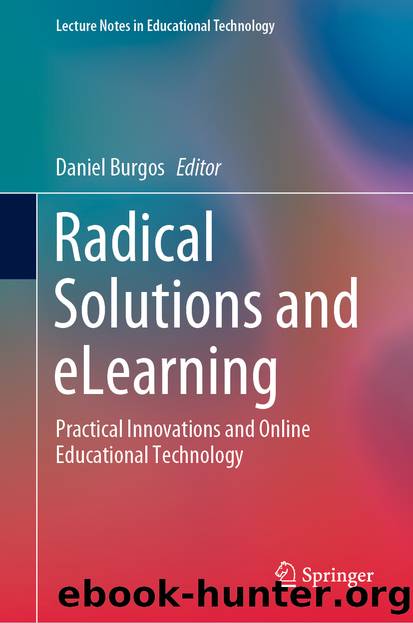Radical Solutions and eLearning by Unknown

Author:Unknown
Language: eng
Format: epub
ISBN: 9789811549526
Publisher: Springer Singapore
8.2 Self-directed Learning
Self-directed learning (SDL) is central to all learning within SDMDL. Knowles (1975, p. 18) defines SDL as “a process in which individuals take the initiative, with or without the help of others, in diagnosing their learning needs, formulating learning goals, identifying human and material resources for learning, choosing and implementing appropriate learning strategies and evaluating learning outcomes”. For Gibbons (2002), SDL refers to “any increase in knowledge, skill, accomplishment, or personal development that an individual selects and brings about by his or her own efforts using any method in any circumstances at any time”. From these definitions, the parameters of the SDL process are clearly drawn.
These definitions also link up with Brockett and Hiemstra’s (2019) statement that, for SDL, a “learner assumes primary responsibility for and control over decisions about planning, implementing, and evaluating the learning experience” (p. 36). Hence the student is at the centre of the educational activity. SDL then not only involves the learning process but also specific characteristics of a student.
Merriam and Bierema (2014) through the following statements distinguish SDL as both a personal attribute and a process: “SDL as a personal attribute refers to an individual predisposition toward this type of learning, and comfort with autonomy in the learning process. SDL as a process is an approach to learning that is controlled by the learner.” (p. 63). For lecturers, both the attribute and process are of importance as this would inform any interventions or actions within the multimodal environment.
Specific essential elements of SDL were identified by Gibbons (2002). These involve students having control of the learning experience as much as possible; students’ skills being developed; students challenging themselves for better performance; students managing themselves and their learning; and students being responsible for the motivation and assessment of themselves.
Within higher education, SDL also takes place within the context of broader multimodal learning, specifically as regards individual preferences, forms of communication, learning as well as delivery. Furthermore, for SDL to be fostered, some access to resources is also implied and hence formal, epistemological and especially demiurgic access are relevant.
SDL does not imply that students function totally independently and in isolation. Due to differing needs by students, varying degrees of support might be necessary. Brockett and Hiemstra (2019) observe that “individuals will vary in their readiness for self-direction thereby requiring varying degrees of assistance by facilitators, especially as self-directed learning skills are developing” (p. 34). Furthermore, SDL is considered a “continuum rather than as some dichotomous model” (Brockett & Hiemstra, 2019, p. 35). Bull (2017) also regards SDL as a spectrum.
In this chapter, it is considered that learning takes place multimodally and within a context that is multimodal.
Download
This site does not store any files on its server. We only index and link to content provided by other sites. Please contact the content providers to delete copyright contents if any and email us, we'll remove relevant links or contents immediately.
What's Done in Darkness by Kayla Perrin(26510)
Shot Through the Heart: DI Grace Fisher 2 by Isabelle Grey(18995)
The Fifty Shades Trilogy & Grey by E L James(18942)
Shot Through the Heart by Mercy Celeste(18873)
Wolf & Parchment: New Theory Spice & Wolf, Vol. 10 by Isuna Hasekura and Jyuu Ayakura(16966)
Python GUI Applications using PyQt5 : The hands-on guide to build apps with Python by Verdugo Leire(16862)
Peren F. Statistics for Business and Economics...Essential Formulas 3ed 2025 by Unknown(16793)
Wolf & Parchment: New Theory Spice & Wolf, Vol. 03 by Isuna Hasekura and Jyuu Ayakura & Jyuu Ayakura(16682)
Wolf & Parchment: New Theory Spice & Wolf, Vol. 01 by Isuna Hasekura and Jyuu Ayakura & Jyuu Ayakura(16307)
The Subtle Art of Not Giving a F*ck by Mark Manson(14243)
The 3rd Cycle of the Betrayed Series Collection: Extremely Controversial Historical Thrillers (Betrayed Series Boxed set) by McCray Carolyn(14061)
Stepbrother Stories 2 - 21 Taboo Story Collection (Brother Sister Stepbrother Stepsister Taboo Pseudo Incest Family Virgin Creampie Pregnant Forced Pregnancy Breeding) by Roxi Harding(13404)
Scorched Earth by Nick Kyme(12704)
Drei Generationen auf dem Jakobsweg by Stein Pia(10908)
Suna by Ziefle Pia(10838)
Scythe by Neal Shusterman(10258)
International Relations from the Global South; Worlds of Difference; First Edition by Arlene B. Tickner & Karen Smith(9468)
Successful Proposal Strategies for Small Businesses: Using Knowledge Management ot Win Govenment, Private Sector, and International Contracts 3rd Edition by Robert Frey(9307)
This is Going to Hurt by Adam Kay(9083)
